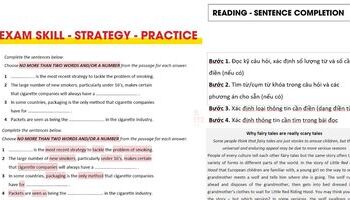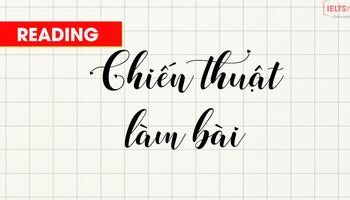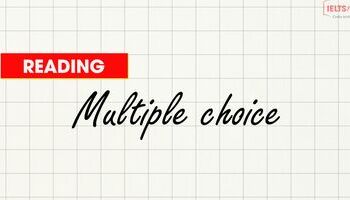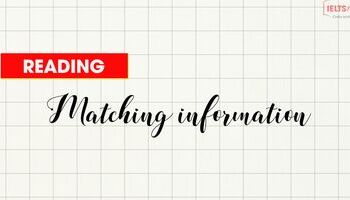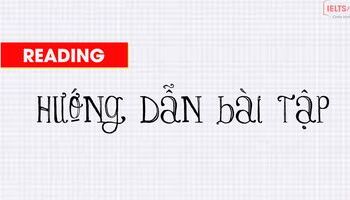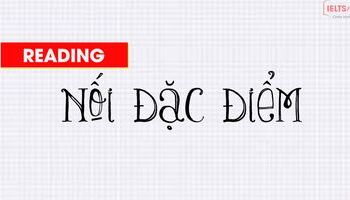Trong IELTS Reading, Sentence Completion không phải là dạng bài xuất hiện nhiều như Multiple Choice nhưng lại có độ khó khá cao mà cần nắm vững chiến thuật để tự tin hơn. Hôm nay, cả nhà cùng luyện các bước làm bài với IELTS Fighter nhé.
Format đề Sentence Completion
Sentence Completion là gì?
Sentence Completion hay Completing sentences trong IELTS Reading là dạng bài sẽ đưa ra cho bạn một số câu chưa hoàn thành và bạn cần phải sử dụng những từ có trong đoạn văn để điền vào câu trả lời. Dạng câu này không quá khó nhưng cần tìm thông tin kỹ cũng như chú ý đến ngữ pháp cẩn thận.
Cùng xem video hướng dẫn cách làm với Ms Huyền nha:
Video luyện tập dạng bài này và lưu ý:
Ở dạng bài Sentence Completion, đề bài sẽ yêu cầu thí sinh hoàn thành những câu khuyết thiếu thông tin bằng cách chọn hoặc điền đáp án đúng vào chỗ trống. Do đó, đáp án đúng có thể được thể hiện dưới dạng chữ cái A, B, C… hay từ và/ hoặc số.
Dạng câu hỏi - format
Sẽ có hai dạng câu hỏi chính như sau:
Dạng hoàn thành câu bằng cách điền từ vào chỗ trống
Đây là dạng điền một đáp án chính xác từ bài đọc để hoàn thành câu cho trước.
| Complete the sentences below. Choose ONE WORD ONLY from the passage for each answer. 1 After 1880, Cutty Sark carried ................................... as its main cargo during its most successful time. 2 As a captain and ..................................., Woodget was very skilled. 3 Ferreira went to Falmouth to repair damage that a ................................... had caused. |
Dạng hoàn thành câu bằng cách chọn đáp án
Đây là dạng lựa chọn một đáp án chính xác trong danh sách đáp án cho trước để hoàn thành câu.
| Complete each sentence with the correct ending, A-F, below. 1 In fairy tales, details of the plot 2 Tehrani rejects the idea that the useful lessons for life in fairy tales 3 Various theories about the social significance of fairy tales
|
Các bước làm bài sentence completion
5 bước làm bài
Bước 1: Đọc kỹ câu hỏi, xác định số lượng từ và số cần điền (nếu có)
Bước 2: Tìm từ/ cụm từ khóa trong câu hỏi và các phương án cho sẵn (nếu có)
Bước 3: Xác định loại thông tin cần điền (dạng điền từ)
Bước 4: Xác định loại thông tin cần tìm trong bài đọc.
Bước 5: Điền/ Chọn đáp án đúng.
Lưu ý về làm bài
Đề bài:
European Settlement of Australia
“European settlement of Australia began in 1788 when a British penal colony was established on the east coast. From this starting point Australia grew rapidly and continually, expanding across the entire continent.
A number of reasons contributed to Britain's decision to colonise Australia. The most important factor was Britain's need to relieve its overcrowded prisons. Several violent incidents at overcrowded prisons convinced the British government of the need to separate unruly elements from the rest of the prison populace.
Additionally, Australia was of strategic importance to Britain, and it provided a base for the Royal Navy in the eastern sea. Also, Australia could be used as an entry point to the economic opportunities of the surrounding region. All these points figured in the decision by Lord Sydney, secretary of state of home affairs, to authorise the colonisation.
To this affect, on May 13, 1787, Captain Arthur Phillip, commanding eleven ships full of convicts, left Britain for Australia. He successfully landed a full fleet at Botany Bay on January 18, 1788. However, they left the bay eight days later because of its openness and poor soil, and settled instead at Port Jackson, a few kilometres north. The ships landed 1,373 people, including 732 convicts, and the settlement became Sydney. Australia Day is now celebrated on 26 January each year, to commemorate this first fleet landing.”
| Complete the following statements using NO MORE THAN THREE WORDS. (put your choice into the gaps - use small letters and don't put any spaces after your last word) 1. Australia was originally founded as a …. 2. The major consideration in colonizing Australia was Britain’s …. 3. It was thought that …… could be gained in that part of the world due to the access provided via Australia. 4. Lord Sydney took every factor into account when he gave official permission for the ….. of Australia. 5. Botany Bay was abandoned by the settlers due to the lack of cover and…. |
Note 1: Đọc kỹ hướng dẫn
Đọc phần hướng dẫn trước, ghi lại số từ mà bạn cần phải viết
Complete the following statements using NO MORE THAN THREE WORDS.
(put your choice into the gaps - use small letters and don't put any spaces after your last word)
Theo đề bài, số lượng từ cần điền không được quá 3 từ. Lưu ý những từ có dấu nối ở giữa như hard-working được tính là 1 từ.
Note 2: Đọc câu đoán từ
Đọc câu chưa hoàn chỉnh, đoán từ sẽ là đáp án đúng: loại từ gì, nghĩa có thể ...
Nếu chưa thể đoán được đáp án chính xác ta có thể đoán được từ loại của từ vựng cần điền.
(1) as a + danh từ
(2) sau sở hữu cách là một danh từ
(3) câu ở mệnh đề that thiếu chủ ngữ -> danh từ, cụm danh từ, danh động từ V-ing
(4) sau “the” ta cần một danh từ
(5) cấu trúc song hành với “and”, trước and là một cụm danh từ nên sau “and” cũng cần một cụm danh từ
Note 3: Tìm kiếm từ đồng nghĩa - cụm từ viết lại câu tương ứng từ khóa
Hãy chú ý các từ đồng nghĩa:
| Question | Từ trong văn bản gốc | Từ đồng nghĩa / hoặc cụm paraphrase |
| 1 | began | founded |
| 2 | most important factor | major consideration |
| 3 | entry point | access |
| region | part of the world | |
| 4 | all these points figured | took every factor into account |
| authorise | official permission | |
| 5 | left | abandoned |
| openess | lack of cover |
Bước 4: Tìm từ khóa
- Có thể xác định từ khóa của câu và hoàn thành câu đó rồi mới chuyển sang câu tiếp theo.
- Đối với hình thức chọn đáp án, số lượng đáp án luôn nhiều hơn số lượng câu cần hoàn thành.
Bạn có thể dùng kỹ năng Scan để tìm từ khóa sau đó xác định câu trả lời.
Đáp án:
1. british penal colony
2. overcrowded prisons
3. economic opportunities
4. colonisation
5. poor soil
Note 5: Kiểm tra các lỗi về ngữ pháp, chính tả.
Ghép các đáp án vào câu để tạo thành câu hoàn chỉnh, ta thấy đã có sự chính xác về mặt ngữ pháp (hòa hợp chủ vị, danh từ số ít số nhiều …) và chính xác về mặt chính tả.
Check- up 1
The War On Smoking
Make no mistake, the move to introduce plain packaging is just the latest front in the war against smoking. Over the past decade, there has been a ban on smoking in public places and moves to restrict displays in shops. But one of the issues that has been concerning health experts and ministers is the number of people who continue to take up smoking, particularly young people.
More than 200,000 under-16’s start in the UK each year – helping ensure a viable market remains for manufactors once the number of people quitting and dying is taken into account. In countries like the UK where there is a ban on advertising, the pack remains the last major vehicle for promotion. Hence the detail and care taken in the design of the packets with their laminated and special print effects, foil decorations and slide openings and beveled edges. It should come as no surprise therefore to learn that they have become known as the “silent salesman” and “mobile billboard” within the industry. They are that important.
Question 1-4
Complete the sentences. Choose no more t han two words and/or a number from the passage for each answer.
………………………. Is the most recent strategy to tackle the problem of smoking.
The large number of new smokers, particularly under 16’s, makes certain that cigarette companies will always have a …………………………
In some countries, packaging is the only method that cigarette companies have for ………………………..
Packets are seen as being the ………………………… in the cigarette industry.
Các mẹo làm bài
Để làm được bài, bạn cần chú ý những mẹo sau:
Mẹo 1: Học kỹ kỹ năng Paraphrasing và tìm từ đồng nghĩa (Synonyms). Parapharasing là kỹ năng viết lại câu bằng từ/cụm từ đồng nghĩa. Và điều này quan trọng trong bài đọc dạng này nhất.
Ví dụ:
Thay vì: “aims to develop power” bạn sẽ có câu khác “focuses on increasing power”
Mẹo 2: Đọc hướng dẫn cẩn thận để biết số từ cần điền, phân loại từ. Nếu đề yêu cầu là “no more than two’, bạn chỉ được phép viết 1 hoặc 2 từ thôi. Nhớ là viết số phải chính xác.
Ví dụ: 72 được tính là một từ, và những từ như “state-of-the-art” được tính là 1 từ.
Mẹo 3: Đọc câu hỏi trước để tìm key, liên kết từ đồng nghĩa để từ đó đọc bài. Khi đọc bài, bạn dùng bút gạch chân key và những từ đồng nghĩa để hiểu rõ hơn thông tin cần điền
Mẹo 4: Thỉnh thoảng câu hỏi sẽ ghi là: ‘using words from the text’ hoặc ‘from the text’. Trong trường hợp này, bạn phải dùng đúng dạng từ trong bài đọc. Còn nếu đề không ghi, có nghĩa là bạn được phép thay đổi dạng thức của từ.
Câu trả lời theo đúng trật tự câu hỏi.
Mẹo 5: Nhớ rằng câu trả lời của bạn cần đúng chính tả nên hãy check loại từ ví dụ động từ, danh từ…để đảm bảo đáp án chính xác hơn.
Mẹo 6: Khi scan tìm câu trả lời, đừng bỏ qua phần viết lại câu và từ đồng nghĩa
Check- up 2
The history of tea
The story of tea begins in China. According to legend, in 2737 BC, the Chinese emperor Shen Nung was sitting beneath a tree while his servant boiled drinking water, when some leaves from the tree blew into the water. Shen Nung, a renowned herbalist, decided to try the infusion that his servant had accidentally created. The tree was a Camellia sinensis, and the resulting drink was what we now call tea. It is impossible to know whether there is any truth in this story. But tea drinking certainly became established in China many centuries before it had even been heard of in the West. Containers for tea have been found in tombs dating from the Han Dynasty (206 BC— 220 AD) but it was under the Tang Dynasty (618—906 AD), that tea became firmly established as the national drink of China.
It became such a favourite that during the late eighth century a writer called Lu Yu wrote the first book entirely about tea, the Ch’a Ching, or Tea Classic. It was shordy after this that tea was first introduced to Japan, by Japanese Buddhist monks who had travelled to China to study. Tea received almost instant imperial sponsorship and spread rapidly from the royal court and monasteries to the other sections of Japanese society.
So at this stage in the history of tea, Europe was rather lagging behind. In the latter half of the sixteenth century there are the first brief mentions of tea as a drink among Europeans. These are mosdy from Portuguese who were living in the East as traders and missionaries. But although some of these individuals may have brought back samples of tea to their native country, it was not the Portuguese who were the first to ship back tea as a commercial import. This was done by the Dutch, who in the last years of the sixteenth century began to encroach on Portuguese trading routes in the East. By the turn of the century they had established a trading post on the island of Java, and it was via Java that in 1606 the first consignment of tea was shipped from China to Holland. Tea soon became a fashionable drink among the Dutch, and from there spread to other countries in continental western Europe, but because of its high price it remained a drink for the wealthy.
Britain, always a little suspicious of continental trends, had yet to become the nation of tea drinkers that it is today. Starting in 1600, the British East India Company had a monopoly on importing goods from outside Europe, and it is likely that sailors on these ships brought tea home as gifts. The first coffee house had been established in London in 1652, and tea was still somewhat unfamiliar to most readers, so it is fair to assume that the drink was still something of a curiosity. Gradually, it became a popular drink in coffee houses, which were as much locations for the transaction of business as they were for relaxation or pleasure. They were though the preserve of middle- and upper- class men; women drank tea in their own homes, and as yet tea was still too expensive to be widespread among the working classes. In part, its high price was due to a punitive system of taxation.
One unforeseen consequence of the taxation of tea was the growth of methods to avoid taxation—smuggling and adulteration. By the eighteenth century many Britons wanted to drink tea but could not afford the high prices, and their enthusiasm for the drink was matched by the enthusiasm of criminal gangs to smuggle it in. What began as a small time illegal trade, selling a few pounds of tea to personal contacts, developed by die late eighteenth century into an astonishing organised crime network, perhaps importing as much as 7 million lbs annually, compared to a legal import of 5 million lbs! Worse for die drinkers was that taxation also encouraged the adulteration of tea, particularly of smuggled tea which was not quality controlled through customs and excise. Leaves from other plants, or leaves which had already been brewed and then dried, were added to tea leaves. By 1784, the government realised that enough was enough, and that heavy taxation was creating more problems than it was wordi. The new Prime Minister, William Pitt the Younger, slashed the tax from 119 per cent to 12.5 per cent. Suddenly legal tea was affordable, and smuggling stopped virtually overnight.
Another great impetus to tea drinking resulted from the end of the East India Company’s monopoly on trade with China, in 1834. Before that date, China was the country of origin of the vast majority of the tea imported to Britain, but the end of its monopoly stimulated the East India Company to consider growing tea outside China. India had always been the centre of the Company’s operations, which led to the increased cultivation of tea in India, beginning in Assam. There were a few false starts, including the destruction by cattle of one of the earliest tea nurseries, but by 1888 British tea imports from India were for the first time greater than those from China.
The end of the East India Company’s monopoly on trade with China also had another result, which was more dramatic though less important in the long term: it ushered in the era of the tea clippers. While the Company had had the monopoly on trade, there was no rush to bring the tea from China to Britain, but after 1834 the tea trade became a virtual free for all. Individual merchants and sea captains with their own ships raced to bring home the tea and make the most money, using fast new clippers which had sleek lines, tall masts and huge sails. In particular there was competition between British and American merchants, leading to the famous clipper races of the 1860s. But these races soon came to an end with the opening of the Suez canal, which made the trade routes to China viable for steamships for the first time.
Questions 1 - 7
Complete the sentences below with words taken from Reading Passage. Use ONE WORD for each answer.
Write your answers in boxes 1-7 on your answer sheet.
1. Researchers believed the tea containers detected in .................... from the Han Dynasty was the first evidence of the use of tea.
2. Lu Yu wrote a....................about tea before anyone else in the eighth century.
3. It was....................from Japan who brought tea to their native country from China.
4. Tea was carried from China to Europe actually by the.....................
5. The British government had to cut down the taxation on tea due to the serious crime of.....................
6. Tea was planted in....................besides China in the 19th century.
7. In order to compete in shipping speed, traders used....................for the race.
Luyện tập có đáp án
PASSAGE 1
Lessons from the Titanic
A. From the comfort of our modern lives we tend to look back at the turn of the twentieth century as a dangerous time for sea travellers. With limited communication facilities, and shipping technology still in its infancy in the early nineteen hundreds, we consider ocean travel to have been a risky business. But to the people of the time it was one of the safest forms of transport. At the time of the Titanic’s maiden voyage in 1912, there had only been four lives lost in the previous forty years on passenger ships on the North Atlantic crossing. And the Titanic was confidently proclaimed to be unsinkable. She represented the pinnacle of technological advance at the time. Her builders, crew and passengers had no doubt that she was the finest ship ever built. But still she did sink on April 14, 1912, taking 1,517 of her passengers and crew with her.
B. The RMS Titanic left Southampton for New York on April 10, 1912. On board were some of the richest and most famous people of the time who had paid large sums of money to sail on the first voyage of the most luxurious ship in the world. Imagine her placed on her end: she was larger at 269 metres than many of the tallest buildings of the day. And with nine decks, she was as high as an eleven storey building. The Titanic carried 329 first class, 285 second class and 710 third class passengers with 899 crew members, under the care of the very experienced Captain Edward J. Smith. She also carried enough food to feed a small town, including 40,000 fresh eggs, 36,000 apples, 111,000 lbs of fresh meat and 2,200 lbs of coffee for the five day journey.
C. RMS Titanic was believed to be unsinkable because the hull was divided into sixteen watertight compartments. Even if two of these compartments flooded, the ship could still float. The ship’s owners could not imagine that, in the case of an accident, the Titanic would not be able to float until she was rescued. It was largely as a result of this confidence in the ship and in the safety of ocean travel that the disaster could claim such a great loss of life.
D. In the ten hours prior to the Titanic’s fatal collision with an iceberg at 11.40pm, six warnings of icebergs in her path were received by the Titanic's wireless operators. Only one of these messages was formally posted on the bridge; the others were in various locations across the ship. If the combined information in these messages of iceberg positions had been plotted, the ice field which lay across the Titanic’s path would have been apparent. Instead, the lack of formal procedures for dealing with information from a relatively new piece of technology, the wireless, meant that the danger was not known until too late. This was not the fault of the Titanic crew. Procedures for dealing with warnings received through the wireless had not been formalised across the shipping industry at the time. The fact that the wireless operators were not even Titanic crew, but rather contracted workers from a wireless company, made their role in the ship’s operation quite unclear.
E. Captain Smith’s seemingly casual attitude in increasing the speed on this day to a dangerous 22 knots or 41 kilometres per hour, can then be partly explained by his ignorance of what lay ahead. But this only partly accounts for his actions, since the spring weather in Greenland was known to cause huge chunks of ice to break off from the glaciers. Captain Smith knew that these icebergs would float southward and had already acknowledged this danger by taking a more southerly route than at other times of the year. So why was the Titanic travelling at high speed when he knew, if not of the specific risk, at least of the general risk of icebergs in her path? As with the lack of coordination of the wireless messages, it was simply standard operating procedure at the time. Captain Smith was following the practices accepted on the North Atlantic, practices which had coincided with forty years of safe travel. He believed, wrongly as we now know, that the ship could turn or stop in time if an iceberg was sighted by the lookouts.
F. There were around two and a half hours between the time the Titanic rammed into the iceberg and its final submersion. In this time 705 people were loaded into the twenty lifeboats. There were 473 empty seats available on lifeboats while over 1,500 people drowned. These figures raise two important issues. Firstly, why there were not enough lifeboats to seat every passenger and crew member on board. And secondly, why the lifeboats were not full.
G. The Titanic had sixteen lifeboats and four collapsible boats which could carry just over half the number of people on board her maiden voyage and only a third of the Titanic’s total capacity. Regulations for the number of lifeboats required were based on outdated British Board of Trade regulations written in 1894 for ships a quarter of the Titanic’s size, and had never been revised. Under these requirements, the Titanic was only obliged to carry enough lifeboats to seat 962 people. At design meetings in 1910, the shipyard’s managing director, Alexander Carlisle, had proposed that forty eight lifeboats be installed on the Titanic, but the idea had been quickly rejected as too expensive. Discussion then turned to the ship’s décor, and as Carlisle later described the incident … ’we spent two hours discussing carpet for the first class cabins and fifteen minutes discussing lifeboats’.
H. The belief that the Titanic was unsinkable was so strong that passengers and crew alike clung to the belief even as she was actually sinking. This attitude was not helped by Captain Smith, who had not acquainted his senior officers with the full situation. For the first hour after the collision, the majority of people aboard the Titanic, including senior crew, were not aware that she would sink, that there were insufficient lifeboats or that the nearest ship responding to the Titanic’s distress calls would arrive two hours after she was on the bottom of the ocean. As a result, the officers in charge of loading the boats received a very halfhearted response to their early calls for women and children to board the lifeboats. People felt that they would be safer, and certainly warmer, aboard the Titanic than perched in a little boat in the North Atlantic Ocean. Not realising the magnitude of the impending disaster themselves, the officers allowed several boats to be lowered only half full.
I. Procedures again were at fault, as an additional reason for the officers’ reluctance to lower the lifeboats at full capacity was that they feared the lifeboats would buckle under the weight of 65 people. They had not been informed that the lifeboats had been fully tested prior to departure. Such procedures as assigning passengers and crew to lifeboats and lifeboat loading drills were simply not part of the standard operation of ships nor were they included in crew training at this time.
J. As the Titanic sank, another ship, believed to have been the Californian, was seen motionless less than twenty miles away. The ship failed to respond to the Titanic’s eight distress rockets. Although the officers of the Californian tried to signal the Titanic with their flashing Morse lamp, they did not wake up their radio operator to listen for a distress call. At this time, communication at sea through wireless was new and the benefits not well appreciated, so the wireless on ships was often not operated around the clock. In the case of the Californian, the wireless operator slept unaware while 1,500 Titanic passengers and crew drowned only a few miles away.
K. After the Titanic sank, investigations were held in both Washington and London. In the end, both inquiries decided that no one could be blamed for the sinking. However, they did address the fundamental safety issues which had contributed to the enormous loss of life. As a result, international agreements were drawn up to improve safety procedures at sea. The new regulations covered 24 hour wireless operation, crew training, proper lifeboat drills, lifeboat capacity for all on board and the creation of an international ice patrol.
Complete the sentences below using words taken from the reading passage. Use NO MORE THAN THREE WORDS for each answer. Write your answers in boxes 1-3 on your answer sheet.
1) One positive outcome was that the inquiries into the Titanic disaster sought to improve safety procedures by initiating ..........
2) The Titanic’s safety feature, which convinced most people that she wouldn’t sink, was her ..........
3) Passenger ships across the North Atlantic Ocean had had an excellent safety record in the ..........
ĐÁP ÁN:
Check-up 1
1. plain packaging
2. viable market
3. promotion
4. silent salesman / mobile billboard
Check-up 2
1. Đáp án: tombs
Từ cần điền tìm được ở câu văn cuối của đoạn văn đầu tiên “Containers for tea have been found in tombs dating from the Han Dynasty ...”
2. Đáp án: book
Từ cần điền tìm được ở câu đầu tiên của đoạn văn thứ 2 “It became such a favourite that during the late eighth century a writer called Lu Yu wrote the first book entirely about tea ...”
3. Đáp án: monks
Từ cần điền tìm được ở câu thứ hai của đoạn văn trên “It was shordy after this that tea was first introduced to Japan, by Japanese Buddhist monks who had travelled to China ...”
4. Đáp án: Dutch
Từ cần điền tìm được ở đoạn giữa của đoạn văn thứ 3 “This was done by the Dutch, who in the last years of the sixteenth century began to encroach on Portuguese trading routes ...”
5. Đáp án: smuggling
Từ cần điền tìm được ở câu đầu tiên của đoạn văn thứ 5 “One unforeseen consequence of the taxation of tea was the growth of methods to avoid taxation—smuggling and adulteration”.
6. Đáp án: India
Từ cần điền tìm được ở đoạn văn thứ 6 “India had always been the centre of the Company’s operations, which led to the increased cultivation of tea in India, beginning in Assam”.
7. Đáp án: clippers
Từ cần điền tìm được ở đoạn văn thứ 7 “Individual merchants and sea captains with their own ships raced to bring home the tea and make the most money, using fast new clippers ...”
PASSAGE 1
(1) international agreements/new regulations
(2) sixteen watertight compartments
(3) previous forty years
Các bạn cùng tham khảo và luyện tập nhé! Bài viết phân tích đề thật được thực hiện bởi IELTS Fighter, vui lòng ghi nguồn nếu sử dụng chia sẻ. Xin cảm ơn.
Xem thêm dạng bài khác:
IELTS Reading: Chiến lược làm bài SHORT ANSWER QUESTION
Các bước làm bài IELTS Reading dạng Matching features
